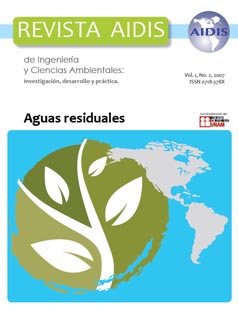Tratamiento de agua residual municipal con bio-reactores UASB de membrana: efectividad y taponamiento
Main Article Content
Abstract
This research assessed the effect of the cellular retention time (CRT) on the removal of contaminants in a laboratory‐scale facility, made up of two UASB bioreactors coupled with membranes. The study determined physicochemical, hydraulic and biological parameters and it was found that the effluent complies with the Mexican legislation for water reuse. The fouling phenomenon was studied in both ultrafiltration modules, and it was verified that the two‐phase mechanism that is typical in filtration tests was periodically repeated, that is, there were successive events in which the flow presented an initial exponential decrease followed by a phase in which it was relatively constant during the long‐time operation of the system under study. According to the theory, each stationary phase is associated with the development of a biofilm, and due to this reason the discussion is focused on the overlapping of biofilms. Similarly, the autopsy of the clogged membranes was carried out including the determination of the biomaterial ultrastructure by electron microscopy, microanalysis of the surfaces by energy dispersion spectroscopy (EDS) and calculations of the microbial populations through the isolation of DNA associated with the biofilms. The data obtained suggest that the biomaterial is made up of overlapped layers of semipermeable biofilms, in which organic and inorganic compounds are mixed within the matrix that makes them up. The tridimensional organization, the presence of inorganic elements with a poor solubility (Ca, Mg), the existence of microorganisms in the innards of the biofilm and, therefore, the presence of their metabolites that work as building blocks, and the prevailing microenvironmental conditions inside the tubular membrane, justified the proposal that the mechanism that makes up each biolfilm could be related to the biologically induced mineralization theory. Thus, final discussion of this work is focused on the mechanical and cohesive properties of the biomaterial generated in each membrane.
Article Details
How to Cite
[1]
Herrera Robledo, M., Morgan-Sagastume, J.M., J. Ergas, S. and Noyola Robles, A. 2009. Tratamiento de agua residual municipal con bio-reactores UASB de membrana: efectividad y taponamiento. Revista AIDIS de ingeniería y ciencias ambientales: Investigación, desarrollo y práctica. 1, 2 (Nov. 2009).
